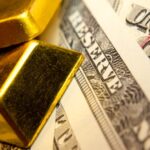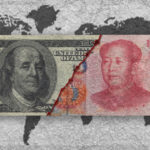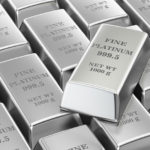Weekly Market Report 10/3/11
GOLD
Gold was up $200+ per ounce during the month of August, and down $200+ in the month of September. Gold is virtually the same price as it was two months ago. In September gold reached a new all-time record high of $1,920.80 per ounce. The volatility that we are seeing in the World’s Gold markets the past two months, and a $300 price range last month, shows that we are entering Phase II of the gold rally. I discussed the various phases of this gold rally in the May Hyperinflation booklet. As the Gold market moves to the $2,000 level by years end, I consider this increased Gold volatility and any market correction as an excellent time to add to your gold holdings. Gold closed Friday September 30th at $1,624.60 per ounce on light weekend trading volume and I think this week will show us that gold has bottomed out and will resume its move higher.
Although I would like to see gold build a new base at above $1,600 per ounce for a couple weeks, I doubt world events will allow that to happen. I think that it is highly possible we will hear an announcement of a sizeable gold purchase by a government in October, and that announcement will be the stimulus for another round of heavy gold demand.
In addition to the continuing bullish supply/demand gold fundamentals that we are seeing, the European countries and banks debt crisis is the key investor concern that is setting the direction of gold prices worldwide on a daily basis. Why is this a key factor in gold trading? Should a deal not be agreed upon by the 17 Eurozone nations, there is virtual certainty that we would see a sovereign country and banking debt default. Although Gold is widely considered the best safe haven investment in a default situation, banks and investors need liquidity and cash, and U.S. short term debt is what they want.
Germany is the key player in the Eurozone deliberations over the debt bailout plan. Germany is in a catch-22 situation. Many of the German political parties are against bailing out the PIIGS countries (Portugal, Ireland, Italy, Greece, and Spain) because of their very liberal entitlement programs for civil servants. However, some of the largest German banks hold sizeable amounts of the PIIGS countries debt. If any of the PIIGS countries are allowed to default, the German government will need to re-capitalize some of the largest German banks in order to prevent them from failing. (More of the Eurozone Bailout plan later in this report)
SILVER
Silver suffered the most in September, down $11.75 or 28% for the month. Silver closed Friday at $30.02 per ounce on light trading weekend volume. Last Monday, Sept. 26th, there was a massive silver trade at $26.15 per ounce as silver bottomed out. Many traders felt this was the 18 million ounces that needed to be liquidated by SLV, the very popular Exchange Traded Fund (ETF). After this massive trade, the Silver market quickly rallied back to over $30 per ounce. Although the $26.15 price could be considered very low, we at least now know where Silver has sizeable support.
Global recession concerns primarily focused on the Eurozone nations and this took its toll on the worldwide Silver, Platinum, and Palladium prices last month. Silver investors were also disappointed with the U.S. Federal Reserve’s September FOMC meeting announcement. Bernanke’s $400 Billion “Operation Twist Program” was considered a minimal effort to deal with the U.S. employment and housing problems. Whether it was for political reasons or conservative monetary policy, the Fed did not take the needed aggressive actions required for economic growth. I believe that the recent Fed policy announcement was not enough for an economic recovery within the U.S. and a couple of Federal Reserve regional Presidents agree. There is always hope that they will consider more monetary stimulus in October.
Because of the global concern for a possible double dip recession, and the reasons listed above, I have changed this Week’s recommended investment commitment and diversification. I have increased gold to 66%, lowered silver to 24%, while leaving Platinum and Palladium alone at 10%.
This Week’s recommended investment commitment and diversification:
Precious Metal commitment: Minimum of 35 % of investment capital
Diversification: Gold 66%, Silver 24%, Platinum & Palladium 10%
Diversification includes long term investment quality rare coins and short term bullion products.
Returning from Europe
On Tuesday Sept. 27th I returned from Europe, having spent time in Paris and Rome. The opportunity to speak with European precious metal professionals and bankers provides me a better understanding of the world’s demand and supplies of gold and silver investment products. Unlike the United States, many of the major banks in Europe buy and sell gold for their own accounts, while carrying large inventories. I started traveling to Europe in the late 1970s and have developed some great relationships with European precious metal and rare coin dealers and bankers. Now, many of these people are senior executives with their companies and banks. We discussed sourcing supplies of the popular European gold coins and I was able to hear their views on European economic and monetary issues.
What did I learn?
Europeans have lost faith in the Euro to the extent that political parties are now running television commercial campaigns promising that if their representatives are elected, they will withdraw from the Eurozone. European investor demand for physical gold has increased from 200% to as much as 500% over the past two years, depending on the source. The favorite gold investment vehicles for European buyers (especially Greek, Spanish, Irish, Italian, and Portuguese buyers) are the 20 Franc French and Swiss coins and the British Sovereigns for historic reasons. Supplies of these popular gold coins have become very scarce over the past year and premiums have increased and demand continues to rise.
As for the economic situation in Europe, the feeling is that the EFSF (European Financial Stability Facility) will be approved by the 17 nation Eurozone community. The EFSF will have an excellent credit rating and be allowed to raise over 4 Trillion Euros in bonds or other debt instruments. The monies will be used to stabilize the value of the Euro and rescue countries and banks holding debt that have a high possibility of default. This is a two to three year quantitative easing (QE) program that will cause inflation to the value of the Euro. Once this EFSF Eurozone stimulus package is funded and announced, the feeling is that demand for gold in Europe could double or even triple.
REMEMBER THE BLOG
If you want to be updated on what is happening in the gold, silver, and rare coin markets any weekday, our company offers a daily blog Monday to Friday at www.mintstategold.com/investor-education/cat/blog/
KFWB NEWS TALK 980 RADIO
Starting today, at 5:06pm PDT, I will be providing the Gold & Silver Minute on KFWB radio. KFWB News Talk 980 is the CBS affiliate for the Southern California area, and can also be heard on the internet at http://losangeles.cbslocal.com/station/kfwb-news-talk-980/
All statements, opinions, pricing, and ideas herein are believed to be reliable, truthful and accurate to the best of the Stuppler & Company’s knowledge at this time. Stuppler & Company disclaims and is not liable for any claims or losses which may be incurred by third parties while relying on information published herein. Individuals should not look at this publication as giving finance or investment advice or information for their individual suitability. All readers are advised to independently verify all representations made herein or by its representatives for your individual suitability before making your investment or collecting decisions.






